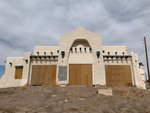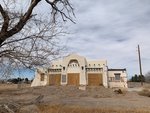Wind: 4.6 mph, W
Welcome to our new web site!
To give our readers a chance to experience all that our new website has to offer, we have made all content freely avaiable, through October 1, 2018.
During this time, print and digital subscribers will not need to log in to view our stories or e-editions.




The Las Cruces City Council will vote March 7 on an ordinance approving zone changes on 75 acres of land generally known as the former Las Cruces County Club property.
If approved, the ordinance will change the property’s zoning from R-1A (single-family medium density) to multiple zones, including commercial, residential and open space, in seven planning areas within the property, which is located at the intersection of Solano Drive and Main Street.
The property is owned by Omaha, Nebraska-based Tetrad Property Group, which is requesting the zone changes so it can begin development. The property, which includes part of the country club golf course that opened in 1928, is currently unimproved except for the country club building that was designed by El Paso architect Henry Trost in the 1920s. It does not include Three Crosses Regional Hospital, which was developed separately.
In July 2018, the city council adopted the Apodaca Blueprint (ABP), which city staff developed as “a guiding land use and development plan” for the property, according to city documents.
The ordinance includes several conditions for approval placed on the proposed zoning changes by city staff “to ensure that the key development attributes in the plan (ABP) are being met,” the city said.
At its Dec. 28, 2021, meeting, the city Planning and Zoning Commission (P&Z) voted unanimously to approve the proposed zone changes. P&Z Chair Harvey Gordon said he voted yes “based on Elevate Las Cruces (the city’s master plan for development), staff discussion, the presentation (at the P&Z meeting), and I have seen this property vacant for quite a long time and I'll be very happy to see it developed.”
The president of a neighborhood association east of the property proposed for development, however, said the ordinance should not be approved by the city council because it “significantly deviates from the blueprint.”
Country Club Neighborhood Association President Eva Nevarez St. John said she does not oppose development of the property, but it should “follow the blueprint as closely as possible.”
The city paid a consultant to create the blueprint and included a lot of public input in the process, St. John said, so, any development plan it approves should be “consistent with the blueprint to benefit neighborhoods and community taxpayers.”
St. John said she is particularly concerned that the proposed rezoning will significantly increase the area’s population density and traffic volume and reduce open space.
“If the developer is using the ABP as its master plan, approved zoning districts must be consistent with the ABP,” St. John said in comments she submitted to city staff. She also voiced her concerns at the P&Z meeting.
“We recognize that there has been significant investment from the community in terms of input into the master plan, as well as taxpayer dollars spent to be able to go through that process to create this plan,” Tetrad representative Cassie Paben said at the P&Z meeting. Master plans “are a basis to start development from,” Paben said. They can have some fluidity to them, although they should be adhered to for the most part. What we’re proposing actually matches what’s in the blueprint.”
City Senior Planner Katherine Harrison-Rogers said city staff worked with Tetrad on a development plan to “meet the strategies and goals outlined in ABP.” The proposed ordinance “meets the intent of APB,” she said.
St. John “has some good points in the document she developed,” Harrison-Rogers said, but it doesn’t consider all the components in city code that affect development.
Harrison-Rogers said city staff can speak to each of the concerns St. John has raised about the ordinance at the March 7 meeting.
At that meeting, city councilors will have the option to approve the ordinance, direct staff to revise it or reject it outright, Harrison-Rogers said. If the ordinance is approved, staff will “monitor development as it proceeds,” she said, and there will be opportunities for additional public input on the development, during the subdivision process and as city staff moves forward with revisions to the city code.